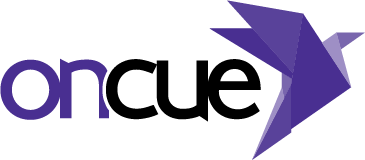









ON-AIR and OFF-AIR – This is OnCue’s Mirror Mode. Click on the red button to switch between them. If you are ON-AIR, anything showed in the viewer is on your presentation screen. If you click to change to OFF-AIR – the document continues to show on your presentation screen but now if you click on another document, it will not show on the presentation screen.

Clicking on the Bird sends the document you are looking at to Presentation. As you can see in the picture below, there are other options.

Publish On-Air – Same as hitting the On-Air button in the Viewer.
Reverse Publish – If you have a document in Presentation and, for some reason, had to move to another document in the Viewer, this puts what is in Presentation in the Viewer.
Stop Presenting – This closes Presentation completely.

ASPECT RATIO – This one is simple. OnCue viewer has 4x3 (standard) or 16x9 (widescreen) and should be chosen based on the aspect ratio of the monitor, TV or projector you'll be presenting to.
TOGGLE TOOLBAR – Turn your toolbar off and on in Presentation. Any change to the tools in the Viewer will be reflected in Presentation so you probably don’t need to use this.
BLANK SCREEN – Blank your screen either in Presentation or in On-Air. It works for both.
BONUS:

Go To – Need to go someplace in a hurry and know the ID? Type the ID where the Go To is and hit the arrow. This immediately puts the doc in the viewer.
Page Navigation – At the bottom of your viewer, the arrows will allow you to page through your document. Need to go to the first page or last page – Click on the numbers i.e., 2.1 or 2.139.












TARGET NOTEBOOK – Add what is in your Viewer to your Target Notebook. As seen below, you can check the option to automatically add published media to your Target Notebook as well. See more details in the Notebooks section.

SAVE ANNOTATION

UPDATE ANNOTATION – You can overwrite an annotation (mark-up, treatment) easily. Don’t like what you did? Redo it and hit Update Annotation.

SELECT – Want to erase the 3rd thing you did? Hit the select tool, click on the one you want and hit Delete.
ERASE – Want to start over and erase everything you did or maybe step back one? The default for the button is Erase Last.
Erase works a little differently than other toolbar icons. Clicking erase (or pressing E / Ctrl-E) performs the erase action without selecting the tool and replacing the mouse cursor. Whichever tool you already have selected will remain selected.
Note: Double-clicking on an annotation deletes it.













Zoom – Hit the button and draw a square with the cursor. This makes what you zoomed in on the width of the screen, while leaving what is around it still showing. You can continue to zoom as needed.
Crop Zoom – Hit the button and draw a square with the cursor. Crop Zoom makes what you zoomed in on the width of the screen and drops what is around it. You can continue to zoom as needed.
Reset Zoom – Takes you back to full page (also default hotkey - F).
Full Width – Zooms your document to the top the page, the full width of your screen.
Full Width, Bottom of Page – Same as above only the bottom of the page.
PRO TIP – If you hold the CTRL Key while right-clicking on your mouse and moving it, you can pan or move the document up and down. This will automatically split your screen horizontally when you get to the bottom of a document. Showing the top of the next. You can continue to “scroll” (not using the scroll wheel) through your pages. Double-clicking on a page, takes it full screen.
Full Height – Returns your document to full page view. Note: this doesn’t work with Panning and double-clicking on a page returns you to full page view.
Split Screens

Split Vertical – Put two pages side by side.
Split Horizontal – Put two pages on top of each other (see more details about how best to do this in the Zoom section.
Single Page – Split Page is a toggle. You can turn it off and the side of the screen you have focus on will be the only doc showing. Double-clicking on the side you want also works.
Select Next Pane – You will notice a light gray box around one of your pages, this is where your focus is. You can annotate (mark-up, treat) that page and then when you want to move to the next one Tab over. Want to move back? Hit Tab again.
Active Frame Color – A light gray box around your active page was mentioned, you can change this to any color or no color (black.)














Callouts
Below are all the options for Callouts. After you draw your callout using the cursor, you can then resize as needed. Forget a line, just hold down your CTRL button and grab the frame of the callout to change the area it is calling out. Just want to make it bigger, grab the corner of a frame without holding CTRL. Want some weird shape? Hold CTRL while you are drawing the callout.

Flat Callout – No fancy stuff – just pull out the section you need keeping the document showing behind it.
Enhanced Callout – This one has connectors (some say “tractor beams” or projection lines) that show the callout popping out of the page.
Show Page Mask – Page shading behind the callout.
Mask Opacity – How much shading do you want? Set as you like.
Mask Color – What color do you want your shading to be?
Connector Style – What do you want your projection lines to look like?
Source Effect – Do you want a drop shadow around the original text on the page?
Callout Effect – Do you want a drop shadow around your callout?
Callout Corner Radius – Do you want your Callout to have rounded corners?
Callout Border Thickness – Do you want your Callout to have a frame? How thick?
Callout Border Color – And what color do you want that Frame?
Need to delete? – Double-clicking on a callout will delete it. In fact, double-clicking on any annotation will delete it.
Highlight

Need to delete? – Double-clicking on a highlight will delete it. In fact, double-clicking on any annotation will delete it

Draw
You can have each tool be a different color. The tools in this section are self-explanatory so we will talk about the options. Remember – you can double-click on anything to delete it.
Tip - Try using the filled polygon and adjust your transparency for oddly shaped highlights.

1. Rounded Corners – (Freehand, Arrow and Line only) just like it sounds, no sharp edges.

2. Blend Mode
Colorize – Ever wanted to change the color of your text? Select Filled Rectangle, set your color and draw your square.
Highlight – just like it sounds, this sets the opacity for you so if you want different colors without changing your highlight tool, this is perfect.
Invert – This does the opposite of the color you chose.
Normal – Standard, regular, usual, you get it.

3. Opacity – 0 to 100%
4. Color – You pick. Every tool can be different.
5. Border Thickness – Want a large frame on your rectangle?

Want custom colors? Select More Colors.. and then choose your color and click Add.
Once they are saved, custom colors will appear as an option below the default color options.









Text

The options are self-explanatory. We are going to discuss how to make it work for you. Note: You cannot double-click to erase a text box.
Once you have selected the text tool, click on the page where you want to type and start typing. Click away from the text to finish or hit enter to see the text box to resize.
To edit, double-click on the text to select the invisible text box, a single click after that allows you to start editing.
A single-click on the text selects the box itself. You can resize or delete it using the Delete Button.
Rotate and Nudge

These are self-explanatory.
The most important thing to remember is that rotating, and nudging do not affect the underlying document. It only affects how it appears in OnCue.
Warning: Nudge is meant to adjust documents that are slightly off center such as scanned documents. Over-nudging your document can cause text and lines to become squiggly.





Step-by-step Instructions
Our document toolbar has a lot going on, so we are going to break it down button by button.
The Viewer Toolbar works for Presentation, any change made on this toolbar is reflected everywhere. You can reset to default by right clicking on it and selecting Reset All Tool Settings.

Our document toolbar has a lot going on, so we are going to break it down button by button.
The Viewer Toolbar works for Presentation, any change made on this toolbar is reflected everywhere. You can reset to default by right clicking on it and selecting Reset All Tool Settings.

  | ON-AIR / OFF-AIR – This is OnCue’s Mirror Mode. Click on the red button to switch between them. If you are ON-AIR, anything showed in the viewer is on your presentation screen. If you click to change to OFF-AIR – the document continues to show on your presentation screen but now if you click on another document, it will not show on the presentation screen.
|
 |  Publish – Clicking on the Bird sends the document you are looking at to Presentation. Publish On-Air – Same as hitting the On-Air button in the Viewer.Reverse Publish – If you have a document in Presentation and, for some reason, had to move to another document in the Viewer, this puts what is in Presentation in the Viewer.Stop Presenting – This closes Presentation completely.
|
 | Aspect Ratio – This one is simple. OnCue viewer has 4x3 (standard) or 16x9 (widescreen) and should be chosen based on the aspect ratio of the monitor, TV or projector you'll be presenting to.
|
 | Toggle Toolbar – Turn your toolbar off and on in Presentation. Any change to the tools in the Viewer will be reflected in Presentation so you probably don’t need to use this.
|
 | Blank Screen – Blank your screen either in Presentation or in On-Air. It works for both.
|
 | Target Notebook – Add what is in your Viewer to your Target Notebook. As seen below, you can check the option to automatically add published media to your Target Notebook as well. See more details in the Notebooks section. |
 | Save Annotation
|
 | Update Annotation – You can overwrite an annotation (mark-up, treatment) easily. Don’t like what you did? Redo it and hit Update Annotation.
|
 |  Zoom – Hit the button and draw a square with the cursor. This makes what you zoomed in on the width of the screen, while leaving what is around it still showing. You can continue to zoom as needed. Crop Zoom – Hit the button and draw a square with the cursor. Crop Zoom makes what you zoomed in on the width of the screen and drops what is around it. You can continue to zoom as needed.Reset Zoom – Takes you back to full page (also default hotkey - F).
|
 |  Full Width – Zooms your document to the top the page, the full width of your screen.Full Width, Bottom of Page – Same as above only the bottom of the page.
PRO TIP – If you hold the CTRL Key while right-clicking on your mouse and moving it, you can pan or move the document up and down. This will automatically split your screen horizontally when you get to the bottom of a document. Showing the top of the next. You can continue to “scroll” (not using the scroll wheel) through your pages. Double-clicking on a page, takes it full screen.
|
 | Full Height – Returns your document to full page view.
Note: this doesn’t work with Panning and double-clicking on a page returns you to full page view.
|
 |  Split Vertical – Put two pages side by side.Split Horizontal – Put two pages on top of each other (see more details about how best to do this in the Zoom section.Single Page – Split Page is a toggle. You can turn it off and the side of the screen you have focus on will be the only doc showing. Double-clicking on the side you want also works.Select Next Pane – You will notice a light gray box around one of your pages, this is where your focus is. You can annotate (mark-up, treat) that page and then when you want to move to the next one Tab over. Want to move back? Hit Tab again.Active Frame Color – A light gray box around your active page was mentioned, you can change this to any color or no color (black.)
|
 | Callouts – Below are all the options for Callouts. After you draw your callout using the cursor, you can then resize as needed. Forget a line, just hold down your CTRL button and grab the frame of the callout to change the area it is calling out. Just want to make it bigger, grab the corner of a frame without holding CTRL. Want some weird shape? Hold CTRL while you are drawing the callout.
 Flat Callout – No fancy stuff – just pull out the section you need keeping the document showing behind it.Enhanced Callout – This one has connectors (some say “tractor beams” or projection lines) that show the callout popping out of the page.Show Page Mask – Page shading behind the callout.Mask Opacity – How much shading do you want? Set as you like.Mask Color – What color do you want your shading to be?Connector Style – What do you want your projection lines to look like?Source Effect – Do you want a drop shadow around the original text on the page?Callout Effect – Do you want a drop shadow around your callout?Callout Corner Radius – Do you want your Callout to have rounded corners?Callout Border Thickness – Do you want your Callout to have a frame? How thick?Callout Border Color – And what color do you want that Frame?Need to delete? – Double-clicking on a callout will delete it. In fact, double-clicking on any annotation will delete it.
|
 | Highlight

Need to delete? – Double-clicking on a highlight will delete it. In fact, double-clicking on any annotation will delete it.
|
    | Draw – You can have each tool be a different color. The tools in this section are self-explanatory so we will talk about the options. Remember – you can double-click on anything to delete it.Tip - Try using the filled polygon and adjust your transparency for oddly shaped highlights.
 Rounded Corners – (Freehand, Arrow and Line only) just like it sounds, no sharp edges.
Blend Mode
Opacity – 0 to 100%Color – You pick. Every tool can be different.Border Thickness – Want a large frame on your rectangle? Want custom colors? Select More Colors.. and then choose your color and click Add.Once they are saved, custom colors will appear as an option below the default color options.
|
 | Text – The options are self-explanatory. We are going to discuss how to make it work for you. Note: You cannot double-click to erase a text box.
 Once you have selected the text tool, click on the page where you want to type and start typing. Click away from the text to finish or hit enter to see the text box to resize.To edit, double-click on the text to select the invisible text box, a single click after that allows you to start editing.A single-click on the text selects the box itself. You can resize or delete it using the Delete Button.
|
 | Select – Want to erase the 3rd thing you did? Hit the select tool, click on the one you want and hit Delete.
|
 | Erase – Want to start over and erase everything you did or maybe step back one? The default for the button is Erase Last.
 Erase works a little differently than other toolbar icons. Clicking erase (or pressing E / Ctrl + E) performs the erase action without selecting the tool and replacing the mouse cursor. Whichever tool you already have selected will remain selected.Note: Double-clicking on an annotation deletes it.
|
  | Rotate & Nudge – These are self-explanatory.
 The most important thing to remember is that rotating, and nudging do not affect the underlying document. It only affects how it appears in OnCue.Warning: Nudge is meant to adjust documents that are slightly off center such as scanned documents. Over-nudging your document can cause text and lines to become squiggly.
|
 Go To – Need to go someplace in a hurry and know the ID? Type the ID where the Go To is and hit the arrow. This immediately puts the doc in the viewer.Page Navigation – At the bottom of your viewer, the arrows will allow you to page through your document. Need to go to the first page or last page – Click on the numbers i.e., 2.1 or 2.139.
|

